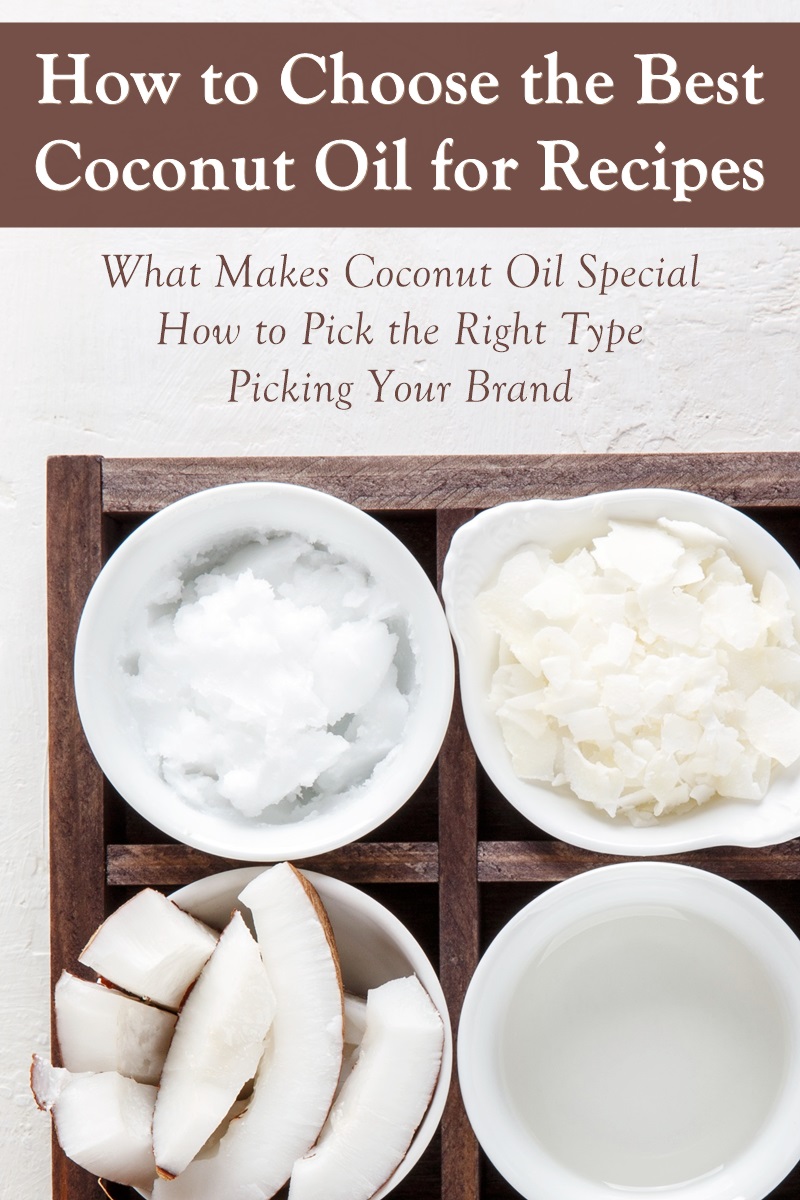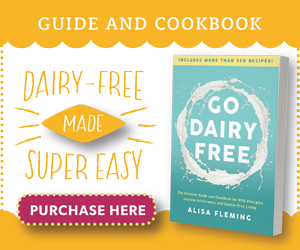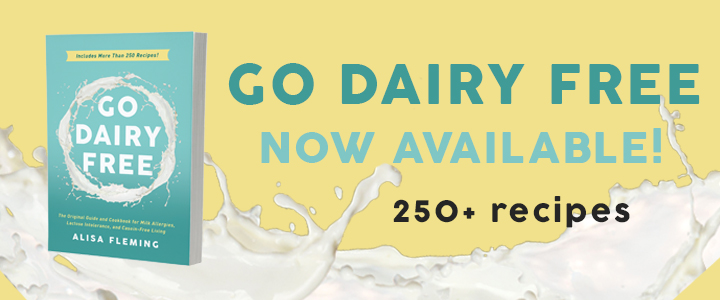I love coconut oil, in moderation. Unlike most other oils, it solidifies at room temperature. This makes it quite useful for those of us who follow a dairy-free diet, and can’t eat butter. In this post I’ll quickly cover what makes this tropical oil special, how to choose the right brand for you, and how to use it in recipes.

How to Choose the Best Coconut Oil for Your Recipes
Dairy butter is high in saturated fat, which is why it is solid at room temperature. Unsaturated fat has a very low melting point, so it stays liquefied, even when stored in the freezer. Oil of any kind is pure fat, but most oils have a ratio of unsaturated to saturated fat that is too high to set up at room temperature. However, coconut oil has a high ratio of saturated fat, so it solidifies once the thermometer hits 77°F or cooler. The only other mainstream oil that has this property is palm oil.
To put it in perspective, here is the percentage of saturated fat in popular fats and oils.
- Coconut Oil – 86% saturated fat
- Dairy Butter – 64% saturated fat
- Palm Oil – 50% saturated fat
- Extra-Virgin Olive Oil – 14% saturated fat
- Canola Oil – 7% saturated fat
How to Use Coconut Oil in Recipes
In general, if a recipe calls for oil, you can usually use coconut oil. Coconut oil has a richer mouthfeel that is quite desirable to many people. But there are a few things to keep in mind.
- If you will be refrigerating or freezing the recipe, coconut oil will cause it to set up more firmly.
- If you choose unrefined coconut oil, it can impart a light coconut flavor. Some people like it or don’t even notice it, others are sensitive to it.
- Do not use coconut oil for greasing if you will be placing the item in the refrigerator or freezer. It will set up and have the opposite effect – like glue instead of nonstick!
Substituting butter isn’t quite as simple. You can substitute coconut oil for butter in most recipes, but it might require some modifications. See my guide on How to Substitute Oil for Butter in Almost Any Recipe.
Coconut oil also works particularly well in raw recipes, like No Bake Cookies or Dairy-Free Fudge. It helps them to easily set up. But I like to make a blend for the best butter substitute.
 I use coconut oil to make my Bakeable Butter (the recipe is in Go Dairy Free: The Guide and Cookbook). It’s a blend that combines a highly-unsaturated oil with coconut oil. This creates a slightly softer consistency that’s more akin to butter. It’s also emulsified to prevent separation. That dairy-free butter recipe works as an alternative for butter in just about any recipe.
I use coconut oil to make my Bakeable Butter (the recipe is in Go Dairy Free: The Guide and Cookbook). It’s a blend that combines a highly-unsaturated oil with coconut oil. This creates a slightly softer consistency that’s more akin to butter. It’s also emulsified to prevent separation. That dairy-free butter recipe works as an alternative for butter in just about any recipe.
How to Choose the Right Type of Coconut Oil
Coconut oil comes in many different types, including unrefined, refined, and liquid forms. Which one you choose depends on your needs.
Unrefined Coconut Oil is often labeled as virgin or extra-virgin. This type of oil undergoes minimal processing and tastes the purest. This is the best option for people who don’t mind the light taste of coconut and who are trying to avoid heavily processed oils. Like most unrefined oils, it has a lower smoke point (350°F), and might not be the best option for high heat recipes.
Refined Coconut Oil undergoes more processing. It’s deodorized and bleached to remove the coconut scent, make it flavorless, and give it a very white color. This makes it a good option for people who don’t like the taste of coconut, or don’t want any coconut influence in their recipe. It also has a higher smoke point (400°F) making it a better option for stir fries and high-heat baking.
Liquid Coconut Oil is fractionated, which removes some of the saturated fat. This allows it to remain a liquid at lower temperatures. It also tends to have a fairly neutral flavor with little to no coconut influence in the taste. Consequently, it’s a more direct substitute for oil in almost any application. But the process of making it a liquid oil does remove some of the purported health benefits of coconut oil.
What about MCT Oil? Tropical oils, like coconut and palm, contain medium-chain fatty acids (MCTs). To create MCT oil, coconut or palm oil is fractionated to separate the different fatty acids and create pure MCT oil. Due to the processing, MCT oil is fairly flavorless, odorless, and colorless. But it has a low smoke point, and isn’t a good option for cooking or baking. People typically stir MCT oil into finished foods as a supplement.
Which Brands of Coconut Oil are Best?
This is really a matter of personal taste. First, you have to choose the type you are looking for. Most refined coconut oil products will have a very similar, neutral taste. But one of the most popular brands for taste and price is Better Body Foods.
Unrefined coconut oil varies just a little bit in flavor and quality from brand to brand. I frequently buy Nutiva, which does have notable hints of coconut, but tastes pure and clean. Viva Naturals is another popular brand. But I’ve also enjoyed many generic brands, including Trader Joe’s and Vitacost.
For liquid coconut oil, Carrington Farms is a good multi-purpose brand, and is actually labeled as cooking oil. It still retains MCT fatty acids, works well in recipes, and is fairly flavorless.
Dairy-Free Recipes to Make with Coconut Oil
These are some favorites from my kitchen, plus a few more recipes that highlight this special ingredient. Please note that this list includes quite a few treats! But you can also use the refined oil as a more general purpose cooking oil in stir fries.
- Vegan Coconut Banana Bread
- Peppermint Fudge Bites
- No Butter Dal Makhani
- Vegan Sweet Potato Cookies
- Raw Cookie Dough Bites
- Rich & Fudgy Brownies
- Strawberry Cheesecake Parfaits
- Almost Classic Chocolate No Bake Cookies
- Thyme Country-Style Biscuits
- No Bake Fruit Crisp Topping
- Strawberry Magic Shell
- Almond Joy Oat Bars
- PB&J Dairy-Free Ice Cream Sandwiches
- Chocolate Pumpkin Butter Cups
- Better than Crocker Baking Mix
- Dairy-Free Coconut Cupcakes with Coconut Oil Frosting
- Sauteed Lemon-Garlic Broccoli(ni)


8 Comments
If your recipe cooks in the oven at 350° F would you recommend or not recommend using unrefined coconut for instance in your danish puff recipe?
I have used unrefined coconut oil in baking recipes at 350, but technically, it would be best to use unrefined just to ensure flavor and health.
Pingback: 13 Reasons Coconut Oil Is Your Best Friend - DIY CHICKS
Pingback: 15 Reasons Coconut Oil Is Your Best Friend | Mcoko.com
Pingback: 15 Reasons Coconut Oil Is Your Best Friend | iMGur3
Pingback: 15 Reasons Coconut Oil Is Your Best Friend -
Pingback: 15 Reasons Coconut Oil Is Your Best Friend - zdouf!
Pingback: 15 Reasons Coconut Oil Is Your Best Friend | GossipViews.com